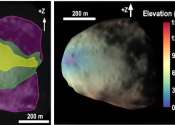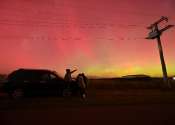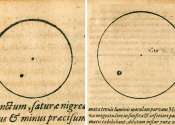Last update:
Planetary Sciences news

NASA smacked a spacecraft into an asteroid—and learned details about its 12-million-year history
NASA's DART mission—Double Asteroid Redirection Test—was humanity's first real-world planetary defense mission.
Astronomy
2 hours ago
0
5

How to SUPPPPRESS light from a star that is ten billion times brighter than its habitable exoplanet
Searching for Earth 2.0 has been an obsession of almost all exoplanet hunters since the discipline's dawn a few decades ago. Since then, they've had plenty of technological breakthroughs help them in their quest, but so far, ...
Planetary Sciences
4 hours ago
0
18

Astrophysicists build model to explain to rapid planet formation
Our solar system is our immediate cosmic neighborhood. We know it well: the sun at the center; then the rocky planets Mercury, Venus, Earth, and Mars; and then the asteroid belt; followed by the gas giants Jupiter and Saturn; ...
Planetary Sciences
5 hours ago
0
32

Additional planet orbiting the star TOI-1408 discovered
Using NASA's Transiting Exoplanet Survey Satellite, an international team of astronomers has detected a second planet orbiting a distant main sequence star known as TOI-1408. The newfound alien world, designated TOI-1408 ...

DART mission sheds new light on target binary asteroid system
In studying data collected from NASA's DART (Double Asteroid Redirection Test) mission, which in 2022 sent a spacecraft to intentionally collide with the asteroid moonlet Dimorphos, the mission's science team has discovered ...
Astronomy
22 hours ago
0
177

The discovery of a new Earth-like planet could shed further light on what makes a planet habitable
In an exciting breakthrough for astronomy and the search for extraterrestrial life, a team of international scientists has announced the discovery of Gliese 12 b, a temperate, Earth-sized exoplanet just 40 light-years away—a ...
Astrobiology
Jul 30, 2024
0
52

Solar storms could cause more auroras
Massive explosions on the sun have triggered warnings of geomagnetic storms that could create dazzling auroras in the northern United States, Europe and southern Australia from Tuesday night.
Planetary Sciences
Jul 30, 2024
0
161

Study suggests cloud-to-ground lightning strikes may have generated building blocks for life on Earth
A large team of chemists at Harvard University has found evidence suggesting that cloud-to-ground lightning strikes may have helped generate some of the building blocks needed for life on Earth to arise.

Has NASA found evidence of ancient life of Mars? An expert examines the latest discovery
NASA has announced the first detection of possible biosignatures in a rock on the surface of Mars. The rock contains the first martian organic matter to be detected by the Perseverance rover, as well as curious discolored ...
Astrobiology
Jul 29, 2024
0
53

NASA Mars rover captures rock that could hold fossilized microbes
NASA's Perseverance Mars rover has made what could be its most astonishing discovery to date: possible signs of ancient life on the Red Planet.
Planetary Sciences
Jul 27, 2024
0
120

Spacecraft to swing by Earth, moon on path to Jupiter
A spacecraft launched last year will slingshot back around Earth and the moon next month in a high-stakes, world-first maneuver as it pinballs its way through the solar system to Jupiter.
Space Exploration
Jul 27, 2024
0
59

Is this how you get hot Jupiters?
When we think of Jupiter-type planets, we usually picture massive cloud-covered worlds orbiting far from their stars. That distance keeps their volatile gases from vaporizing from stellar heat, similar to what we're familiar ...
Planetary Sciences
Jul 26, 2024
0
43

How solar storms play havoc with our lives
Despite the 150 million kilometers that separate it from the Earth, the sun does more than just light our way: it also impacts our electricity networks, and even our transport.
Planetary Sciences
Jul 26, 2024
0
38

Kepler's 1607 pioneering sunspot sketches solve solar mysteries 400 years later
Using modern techniques, researchers have re-examined Johannes Kepler's half-forgotten sunspot drawings and revealed previously-hidden information about the solar cycles before the grand solar minimum.
Planetary Sciences
Jul 26, 2024
0
86

Perseverance rover discovers rock with potential signs of ancient life
A vein-filled rock is catching the eye of the science team of NASA's Perseverance rover. Nicknamed "Cheyava Falls" by the team, the arrowhead-shaped rock contains fascinating traits that may bear on the question of whether ...
Astrobiology
Jul 25, 2024
0
245

A pair of CubeSats using ground penetrating radar could map the interior of near-Earth asteroids
Characterizing near-Earth asteroids (NEAs) is critical if we hope to eventually stop one from hitting us. But so far, missions to do so have been expensive, which is never good for space exploration.
Planetary Sciences
Jul 25, 2024
0
5

Image: A Saturnian summer
NASA's Hubble Space Telescope captured this image of Saturn and its colossal rings on July 4, 2020, during summer in the gas giant's northern hemisphere. Two of Saturn's icy moons are also clearly visible: Mimas at right, ...
Astronomy
Jul 25, 2024
0
52

What lunar caves tell us about the shared origins of the Earth and the moon
Using radar, a Nasa spacecraft, Lunar Reconnaissance Orbiter (LRO), has confirmed the existence of caves beneath the lunar surface. Here's why such geological features will be key for establishing a base on the moon, and ...
Planetary Sciences
Jul 25, 2024
2
51

Geoscientists narrow timing of enormous 'magmatic event' on the moon more precisely
A team of geoscientists affiliated with several institutions in the U.S. and Switzerland has more precisely dated an enormous "magmatic event" that occurred on the moon several billion years ago.

Carbon oxides on Uranus' moon Ariel hint at hidden ocean, Webb telescope reveals
The surface of Uranus' moon Ariel is coated with a significant amount of carbon dioxide ice, especially on its "trailing hemisphere" that always faces away from the moon's direction of orbital motion. This fact presents a ...
Planetary Sciences
Jul 25, 2024
0
77
More news

NASA's ICON mission ends with several ionospheric breakthroughs

Chinese lunar probe finds water in moon samples

NASA rocket discovers new energization process in upper atmosphere

Moon dust could contaminate lunar explorers' water supply

Introducing Ramses, ESA's 2029 mission to asteroid Apophis

NASA's Curiosity rover discovers a surprise in a Martian rock

A new explanation for Jupiter's shrinking Great Red Spot

Ground conditions can impact lunar swirls, study finds

Exoplanet-hunting telescope to begin search for another Earth in 2026
Other news

Probing carbon capture, atom-by-atom with machine-learning model

New discoveries regarding tomato hormones can increase total yield

Strong El Niño makes European winters easier to forecast

New technique measures superconductivity at very high pressures

Bright prospects for engineering quantum light

Grain boundaries weaken in planetary interiors, research suggests

New ultra-hot Neptune-sized exoplanet discovered

New analysis of Cassini data yields insights into Titan's seas

Bennu asteroid samples unveiled

Here's how AI Is changing NASA's Mars rover science

Researchers discover how the NMDAR protein performs a 'Twist'-like dance move

Scientists solve mystery of DNA damage detection and repair caused by sunlight, alcohol, and pollution

One year on 'Mars': Inside NASA's ultra-realistic isolation study

Autonomy boosts college student attendance and performance














































